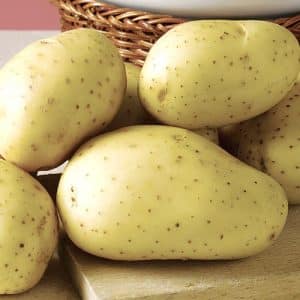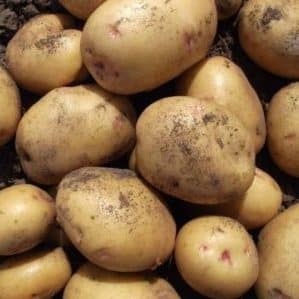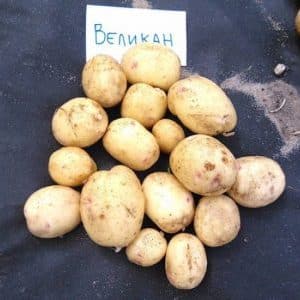High-yielding potato variety Giant with large tubers
Potatoes are an integral part of the modern human diet. It is used to prepare first and second courses, baked goods and even unusual desserts. Experienced housewives say that it is better to choose different varieties of potatoes for boiling, frying and mashing. However, there are also universal options. They are the most popular among gardeners.
These varieties include the Giant potato. It is suitable for preparing any dishes and has a rich taste. This is not the only thing the variety is famous for. It has other advantages that make it increasingly popular - high yield, disease resistance, large fruit and transportability.
General description of the variety
The giant is a product of domestic selection. His resident is the A. G. Lorch Research Institute. The variety is relatively young. It was included in the Russian State Register in 2013. Since then, the Giant has managed to win the love of many gardeners.
Distinctive features of the Giant
The main distinguishing feature of the Giant potato is the aligned large tubers. They make up the vast majority of the harvest; non-commercial small items are extremely rare.
Important! The size of potatoes of this variety depends on the composition of the soil. The more nutritious the soil, the larger the tubers will be.
Giant contains an increased amount of starch. Thanks to this property, the variety acquires a golden-brown, crispy crust when fried and baked.
 Potatoes contain many beneficial substances. Among them:
Potatoes contain many beneficial substances. Among them:
- vitamins B, A, C, PP, K, E, betaine, beta-carotene, lutein;
- micro- and macroelements - potassium, calcium, zinc, selenium, manganese, phosphorus, sodium, magnesium, iron;
- fatty acids, including Omega-3 and Omega-6;
- nonessential and essential amino acids.
Main characteristics of the Giant potato
Potato Giant is a variety that definitely won’t let you down. It produces a rich harvest even in dry summers and is unpretentious.
Characteristics of the Giant potato:
| Parameter | Index |
|---|---|
| Ground part of the plant | The bushes are tall, semi-erect. Medium spreading. Abundantly form green mass. The leaves are large, with a wavy edge. The color is dark green, dull, matte. The veins are clearly defined. The inflorescences are compact and consist of small red-violet flowers. Few berries are produced. The plant fades quickly. The root system is powerful. 10-15 large tubers are formed under each bush. |
| Tubers | Large, aligned, oval-rounded. The weight of each tuber varies between 100-150 g. The skin is thin but durable, glossy, smooth, and light beige in color. The pulp is creamy, yellowish. The taste is sweetish, the aroma is rich. Doesn't darken when cutting. During heat treatment it becomes moderately crumbly, but not is overcooked. There are many eyes, they are deep but inward and pigmented with pink color. The starch concentration in tubers is high - 17-19%. |
| Ripening time | Mid-season. It takes 70-90 days from sowing tubers to harvesting. |
| Productivity | High. With 1 m² landings harvest up to 5 kg of crop. One bush produces up to 15 tubers. They are all large. Marketability reaches 97%. |
| Transportability | High. Tubers are suitable for transportation over long distances.They are stored throughout the winter without changing their taste. |
| Immunity to disease | It has high immunity to potato cancer, leaf curl, striped and wrinkled mosaic, rhizoctonia, and scab. Resistance to late blight and golden nematode is low. |
| Features of cultivation | Recommended for cultivation in the Central, Central Black Earth and Volga-Vyatka regions. |
The main advantages and disadvantages of the variety
Advantages of the Giant:
- versatility of use;
- excellent taste of tubers;
- drought resistance;
- immunity to temperature changes;
- immunity to most nightshade diseases;
- large fruit;
- high transportability and keeping quality.
Disadvantages of the Giant:
- low resistance to late blight and golden nematode;
- demands on soil composition.
Features of planting and growing
Potatoes are grown using the seedless method, planting the tubers directly into the ground. This is done when the soil at a depth of 15 cm warms up to a temperature of +10°C. If you do this earlier, the tubers will rot.
In regions with a temperate climate, potatoes are planted in late April or early May, and in southern cities - in early April. They begin to prepare for this no later than a month in advance.
Preparing for planting tubers
Planting material is sorted out. Large tubers without signs of disease or damage are suitable for cultivation.
To protect potato plantings from diseases and increase their resistance to negative environmental factors, it is important to properly prepare them:
- Treat with a light pink solution of potassium permanganate or copper sulfate (1 tsp per 3 liters of water). The tubers are immersed in this product for half an hour. Then dry completely.
- Next time, rinse the tubers with a solution prepared from 3 liters of water and 0.5 tsp.boric acid. The processed potatoes are allowed to dry completely.
- Stimulate the formation of sprouts. To do this, potatoes are immersed in any growth stimulator (“Solution”), prepared according to the instructions.
The processed potatoes are laid out on sawdust or newspaper in a bright place. Periodically, the tubers are sprayed with water at room temperature.
After 2-4 weeks, sprouts appear on the planting material. When they become strong and long, the tubers are removed to a room with a temperature of +10...+12°C for 48 hours.
Soil preparation and sowing of planting material
To grow the Giant variety, choose the most illuminated place with deep groundwater.
Nightshade crops should not grow in the selected beds for the past 2 years. The best predecessors for potatoes are cabbage, onions, carrots, garlic, any herbs and green manure plants.
They begin preparing the beds in the fall. They are dug up to a depth of 30 cm and all the larvae are removed. The plants are examined: if there are no signs of disease, then they are buried in the ground.
For every 1 m² in the fall, 5-6 kg of manure must be added. Slightly acidic soils are suitable for potatoes. If the indicators are elevated, they are corrected using dry lime or ash.
Advice! Instead of plant tops in the fall, peelings of fruits and vegetables, stale bread and other food waste are buried in the ground.
In the spring, the beds are dug up again to the depth of a spade bayonet. Pest larvae are removed again. To enrich the soil composition, 30 g of superphosphate and 15 g of urea are added for every 1 m². Some gardeners additionally add 4 kg of humus. Fertilizers are thoroughly mixed with the soil.
Potato holes are placed in rows in a checkerboard pattern.A distance of 30 cm is maintained between the recesses, and 60-80 cm between the rows. The depth of the holes varies from 6 to 10 cm.
A handful of ash or long-acting granular fertilizers are thrown into each hole. Then place 1 potato at a time and cover them with soil without compacting the soil. The beds are watered.
Basic rules of care
The Giant's harvest depends on its care. To get maximum performance, it is important to follow the basic rules:
- Tubers planted in the ground need good air exchange. Therefore, the soil is loosened at least 2 times before the first shoots appear. This is done with a rake, removing weeds.

- The beds are loosened after each watering and rainfall and regularly cleared of weeds.
- In dry summers, potato beds are watered 3-4 times. The first watering is done before the first hilling. Then the soil is moistened once before flowering, when the first inflorescence appears and after the bushes have faded. Warm water is used for irrigation. The procedure is carried out after sunset or early in the morning. If the summer is rainy, it is not necessary to water the beds.
- Potatoes are hilled at least 2 times. This allows you to significantly increase the productivity of the Giant. The first time the soil is raised with ridges by 6 cm, when the plants reach a height of 15 cm. The second time - after 2-3 weeks. Then hilling is carried out only if the ridges have been washed away by precipitation. The soil for this is taken from the row spacing.
The giant is demanding when it comes to feeding. They are the ones who allow you to get maximum yield. Over the entire season, fertilizers are applied to potato beds at least 4 times:
- After 2 weeks, after the shoots appear, the potatoes are fertilized for the first time. Most gardeners recommend using chicken manure or mullein diluted with water in a ratio of 1:10.Apply 1 liter of product to each plant. Sometimes this composition is replaced with a urea solution or silage.
- The Giant is fed the second time when the first bud is formed. During this period, it is recommended to use any fertilizer that contains potassium and phosphorus or ash, diluted at the rate of 1 tbsp. for 1 bucket of water.
- The last time fertilizing is applied is during the period of mass flowering. It is useful to use herbal infusion. To prepare it, fill a quarter of a bucket with chopped herbs and add 1 kg of chicken manure. Everything is poured with ice water and left to infuse for several days.
- The last feeding is foliar. 10 days before harvesting, the plants are sprayed with a superphosphate solution (25 g per 1 bucket of water).
Advice from an experienced summer resident
Weeding is the most unpleasant part of growing potatoes. Therefore, farmers have found a way to do without this procedure, as well as loosening the soil. To do this, the beds are covered with a layer of straw, updating it after each watering.
This layer protects plants not only from weeds, but also from many pests.
Disease and pest control
Potato Giant has low resistance to late blight. To avoid infection of plants, they are sprayed with a solution of copper sulfate (1 tablespoon per bucket of water) during epidemics, after rains and during cold snaps. Affected plants are removed and thrown away, after which the soil and healthy bushes are treated with fungicides.
The most dangerous pest that affects the Giant is the nematode. Diseased plantings cannot be saved. To prevent the disease, nematicides are added to the beds a month before planting the tubers.
Note! Nematicides have a phytosuppressive effect.Therefore, after laying the tubers, they cannot be added.
To protect plants from the Colorado potato beetle, bushes are treated with folk remedies (soap solution, ash, decoction of bitter herbs) or special preparations (“Taboo”, “Barrier”). Many gardeners do not treat bushes against this pest, but collect it by hand.
You can protect plants from mole crickets and wireworms by removing their larvae when digging the beds.
Harvest and storage

The Giant harvest is ready for harvest in early August. This is evidenced by the withered tops of plants. Summer residents recommend cutting off potato tops during the harvest week. Then the fruits will be the most delicious.
Potatoes are dug up with a pitchfork to cause minimal damage. Since the tubers are light in color, they are easy to spot in the ground.
Important! Potatoes are dug up only in dry weather. Otherwise, the tubers will turn out dirty.
After removing the potatoes from the ground, they are allowed to dry and carefully cleaned of dirt with a dry material. Then it is sorted out, removing all damaged and infected tubers. They are sorted by size; small and large potatoes are recommended to be stored separately.
Tubers the size of a chicken egg are immediately laid on the seeds. They are stored separately from the rest of the crop.
Potatoes are placed in wooden boxes, plastic nets or dry, clean bags and stored in a dry, dark place.
Giant – potatoes of excellent quality, universal in use. Suitable for boiling, frying, baking and pureeing.
Farmers' reviews of the Giant
The Giant potato variety is distinguished by aligned tubers - exactly as in the photo and in the description from the originator. Reviews from summer residents about this culture are mostly laudatory.
Irina, Voronezh: «I tried many varieties of potatoes, including blue ones. Last year I planted the Giant. A really worthy option. Not to say that it is a giant, but it practically does not produce small tubers. And the taste is excellent. I grew it using the standard method, in holes, and applied only three feedings during the season. The harvest was amazing. I like that potatoes are good when fried and don’t fall apart when cooked.”
Alexander, Kursk: “I liked the giant. Large tasty potatoes. The pulp is yellow. The crust is smooth and creamy, just like the photo. The only negative is that last year I fell ill with late blight. Therefore, processing needs to be given a lot of attention. In the second half of summer, once a week I spray the bushes with copper sulfate.”
Read also:
Who grew the largest potato in the world and what it looks like.
What are the benefits of potato juice for hair and how to use it correctly.
What is the calorie content of potatoes and do they make you fat?
Conclusion
Giant is a high-yielding variety whose performance exceeds all standards. Moreover, almost all of its tubers are large and have the correct shape. If you need a universal option with a stable harvest, you should take a closer look at this variety.
To prevent the Giant from disappointing you, it is important to fertilize in a timely manner and follow the rules for disease prevention.